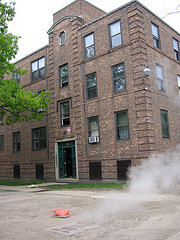
At a Chicago Housing Authority committee meeting Wednesday, Commissioner Myra King announced she will vote no on the authority’s 2013 Moving to Work Annual Plan, primarily because it calls for the demolition of at least 648 homes throughout the city.
The annual plan is a requirement of an agreement the agency signed with the U.S. Department of Housing and Urban Development in 2000. HUD funding, which makes up the vast majority of the housing authority’s $954 million budget is contingent on the plan being approved and submitted by Oct. 18. In 2011 Chicago received more than $800 million from HUD thanks to Moving to Work, a 10-year plan now entering its 13th year.
The major goal of Moving to Work was renovating or replacing 25,000 public housing units throughout Chicago by 2010. The authority’s 2013 plan aims to have 88 percent of those units completed by the end of next year. That is the same unrealized goal the group put forth in last year’s plan for 2012.
King and others say the housing authority has been too quick to demolish homes, and too slow to rebuild or renovate them.
In 2011, the most recent year for which an annual report is available, the authority used $12.2 million less in construction funds than expected, which was “largely the result of capital construction” projects being delayed, according to the report.
King said she would not vote for any more demolition until construction began at the former sites of the Harold Ickes Homes, located at 23rd Street and South Dearborn Avenue, and LeClaire Courts at West 42nd Street and South Cicero Avenue. LeClaire was closed in 2009 and demolished in 2010; Ickes was closed in 2010 and now sits vacant. No work is planned for either site next year.
Together LecLaire and Ickes had more than 1,300 units at their peaks.
“I will not vote for any demolition because we haven’t built back anything from the demolition that we have already done,” King said.
The 2013 plan calls for the construction or rehabilitation of 88 new public housing units next year, and for the possible demolition of more than 1,000 uninhabitable units. The housing authority also plans to add 257 units through property acquisition and another 180 through its rental assistance program.
Housing authority CEO Charles Woodyard said the plans for demolition were not definite and were instead a “first step” toward dialogue with public housing residents.
“We’re not going to demolish any units … unless after we have a long stakeholder process … we say that we are going to demolish units,” Woodyard said.
The 2013 plan states redevelopment of the Frances Cabrini Rowhouses, 900 N. Hudson Ave., “may include the demolition of some or all of the remaining 437 non-rehabilitated units,” but it is unequivical on the issue of demolition at Altgeld Gardens and Phillip Murray Homes at 976 E. 132nd Place.

“CHA has determined that it will undertake planning for the demolition of the remaining 648 non-rehabilitated, unoccupied dwelling units at Altgeld/Murray in FY2013, which includes 466 non-rehabilitated units at Altgeld Gardens and 182 units at Phillip Murray Homes,” the plan reads.
Woodyard insisted after Wednesday’s Operations and Facilities Committee meeting that the strong language does not mean the housing authority is planning to demolish the units, saying it is simply “one idea.” When asked why no other options were listed on the report, Woodyard said demolition had to be featured because “if you don’t have it in the plan, you can’t consider it, you can’t do it.”
Fred Hudson, treasurer of the Lathrop Homes Local Advisory Council, said Woodyard’s talk of a dialogue with stakeholders was just that: talk, and he believes the housing authority has already made its mind up about what it will do, regardless of community input.
Hudson attended Wednesday’s meeting with a small contingent from Lathrop Homes, 2000 W. Diversey Ave., who came looking for answers about the future of their community.
In a flyer King passed out after the meeting, she listed several more reasons she would be voting no on the plan including the lack of movement on construction at Lathrop Homes.
“The plan should be revised for the immediate rehabilitation for some of the existing units at Lathrop Homes,” the flyer reads.
According to the 2013 plan, there are 748 uninhabitable units sitting vacant at Lathrop Homes. No work is planned in 2013.
The future of Lathrop has been debated for years, and Hudson said he has no idea what will happen to the area.
A spokeswoman for the housing authority said three possible plans will be presented in November, and she would not rule out the possibility that some residents will be relocated.
Ald. Scott Waguespack (32nd) released preliminary drafts of the three proposals on his website in September, and in those plans, affordable housing units could be decreased to less than half of their current number.
Related articles
 CN September 27, 2012(chicagonewsroom.org)
CN September 27, 2012(chicagonewsroom.org)













Be First to Comment